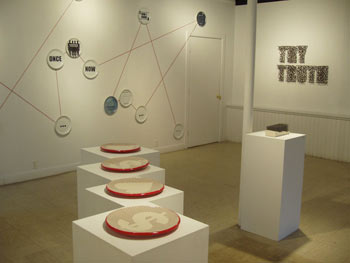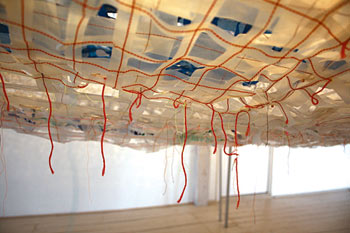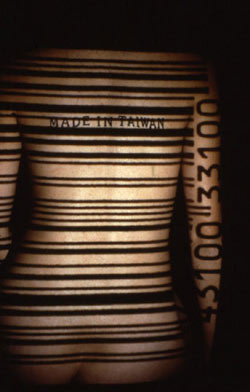September 2009
Three who dare to be not square.
by Caley Bryce Ostrander
Ian Anderson
 You might think you know a person but there’s always something more,” says Ian Anderson, 36, who brushes off pressures to create comfy art in favor of installations that keep you up at night.
You might think you know a person but there’s always something more,” says Ian Anderson, 36, who brushes off pressures to create comfy art in favor of installations that keep you up at night.
Cuddle up to Killer, for example. Underneath a phalanx of exploding black needles hides the word in type, chilling in its understatement, waiting to be discovered. “Your first impression is spikes. You can’t see where it’s written at all.” Then, almost when it’s too late, “the second impression is something different.” He was such a nice boy…
Or consider Abandon Your Ideals, clean white letters impaled by slick black quills. The message pricks both the individual and society, suggesting the barbed wires we can’t always see.
Priced “between $450 to $1,800,” his assemblages dare to provoke as well as delight, which dovetails deftly with his position as Associate Dean of Academic & Student Affairs at Maine College of Art. “I want my students to think deeply and broadly not only about art, but their place in the world.”
Anna Hepler
 “It’s really frightening on one hand, but it’s also incredibly exhilarating,” says Anna Hepler, 39, of the charge she gets when she’s knocked out with her next new idea.
“It’s really frightening on one hand, but it’s also incredibly exhilarating,” says Anna Hepler, 39, of the charge she gets when she’s knocked out with her next new idea.
Like turning weather into an object of startling beauty.
Gyre is a massive, cloud-like structure that hangs downward from the ceiling of venues including the Center for Maine Contemporary Art last winter and spring.
Is it a storm, a concatenation of feminine imagery, or a Portuguese man of war?
Swept skyward in sheets of salvaged plastic and tarps woven together by hand, the diaphanous presence is illuminated by bright lights on the ceiling–with a little help from ten of Hepler’s closest friends.
“It has this really kind of round, full belly to it, a singular spirit,” the former Bowdoin art professor says, adding that Gyre is more than the object itself–it’s the animus it reflects: “The way the light dapples through the netting, it makes these ripples on the wall which make people feel as if they’re underwater. There’s a glow” that’s shared by both this parturient installation and its witnesses, “a kind of soft experience.”
So…wait a minute. The gallery visitors, including groups of children, are part of the seen (see figure in black, left), as well as the seeing?
“Oh, definitely.”
Ling-Wen Tsai
 “My work is rather subtle, quiet, introspective. But behind that quiet appearance is something a bit louder. It’s subtle but strong,” says Ling-Wen Tsai, 39, of Portland. Originally from Taiwan, Ling-Wen moved to the U.S. in 1995 to pursue art and now teaches at Maine College of Art in Portland.
“My work is rather subtle, quiet, introspective. But behind that quiet appearance is something a bit louder. It’s subtle but strong,” says Ling-Wen Tsai, 39, of Portland. Originally from Taiwan, Ling-Wen moved to the U.S. in 1995 to pursue art and now teaches at Maine College of Art in Portland.
A multifaceted artist, Tsai has recently taken up film and performance art, most of which feature herself. Her installation Made in Taiwan, a videotaped performance, shows her bare back illuminated in darkness with a barcode projected onto it, including the words “Made in Taiwan” at the bottom.
During the performance, careful not to show her face, she speaks, “My name is Ling-Wen Tsai, and I come
from Taiwan.”
She then translates the message in Mandarin as the camera pans out on the bar code projected onto her bare body.
“My earlier work responds to my transition from Taiwan to the States. It’s about the struggle in the process of adjusting between two languages and cultures and trying to reconcile and adapt.
“In Asia, so much is about respect and community and consideration for other people. Here, we’re more expressive and individualistic. Both have their pros and cons.”
As her angle of attack evolves, Tsai’s work is accelerating into collaboration with others in her performances. “Now that I’ve been living in the U.S. for a while, my focus is shifting to something more universal.
“I started with my own personal concern, but now I’m interested in showing the relationship of the individual to the world and what it means to be human, which is something everyone can relate to. I want to show we should all care about each other and be considerate about others as humans.”
For Tsai, visual arts is the dead-on strike to convey this idea of universality. It’s something we can all understand. “Visual art is a language no other language can express. If we could only hear what I’m seeing.”





0 Comments